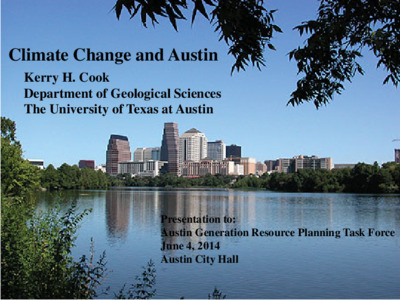Item 3: Presentation from Dr. Kerry H. Cook, UT Jackson School of Geosciences — original pdf
Backup

Climate Change and Austin Kerry H. Cook Department of Geological Sciences The University of Texas at Austin Presentation to: Austin Generation Resource Planning Task Force June 4, 2014 Austin City Hall Projections from Regional Model Simulations Cross-checked with IPCC projections on coarser resolution and validated against observation of current climate Outer domain with 90-km resolution (~10,000 grid points) Inner domain with 30-km resolution (~7,500 gridpoints) Climate models are governed by the laws of physics: F = ma 1st law of thermo conservation of mass for air conservation of mass for water vapor heat balance calculation at the surface Two 20-year simulations •1981 – 2000 late 20th century Observed lateral and surface boundary conditions; observed greenhouse gas concentrations (340 ppm to 371 ppm) •2041 – 2060 mid 21st century Observed lateral and surface boundary conditions + anomalies; CO2 increased (533 ppm to 578 ppm according to an IPCC business-as-usual emissions scenario) References: Patricola, C. M., and K. H. Cook, 2013a: Mid-twenty first century climate change in the central United States. Part I: Regional and global model predictions. Climate Dynamics, 40, 551-568. Patricola, C. M., and K. H. Cook, 2013b: Mid-twenty first century climate change in the central United States. Part II: Climate change processes. Climate Dynamics, 40, 569-583. Projections for 2050: Surface Temperature Difference (°F) Business-as-Usual Emissions Annual Mean Winter Spring Fall Summer Source: Professor Kerry H. Cook, Dept. Geological Sciences, The University of Texas at Austin Changes in the number of 100°F days for the Austin area late 20th c. mid 21st c. Source: Professor Kerry H. Cook, Dept. Geological Sciences, The University of Texas at Austin 2040-2060 1980-2000 90 < A < 105 “extreme caution” fatigue, heat cramps 105 < A < 120 “danger” heat exhaustion likely 120 > A “extreme danger” heat stoke imminent Heat Stress Categories: Apparent Temperature (A) Projected monthly changes in the number of Extreme Caution and Danger heat stress days for the Greater Austin averaging region (30°N-30.5°N; 97°W-98.5°W) late 20th c. mid 21st c. Change in extreme caution heat stress days Change in danger heat stress days 2040-2060 2040-2060 1980-2000 1980-2000 Annual Precipitation Differences (%) 7.5% reduction in annual rainfall (blue triangle = Austin) Source: Professor Kerry H. Cook, Dept. Geological Sciences, The University of Texas at Austin Seasonal Precipitation Differences (%) Summer: 15% reduction Winter: 5% reduction Source: Professor Kerry H. Cook, Dept. Geological Sciences, The University of Texas at Austin Two sources of uncertainty: 1. Variations in the temperature prediction from one model to another 2. Future emissions Source: Intergovernmental Panel on Climate Change (IPCC) Future Emissions Rates are Crucial for Determining How Much Climate Will Change Thank you